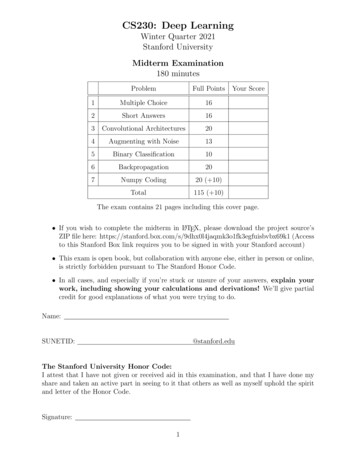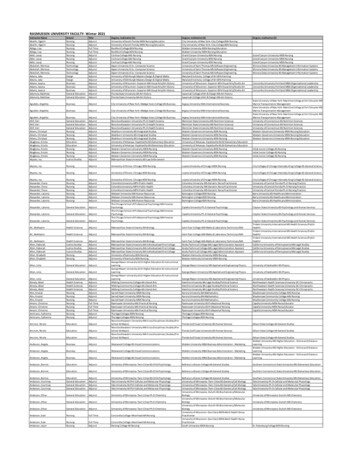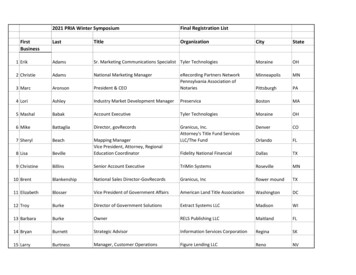
Transcription
CS230: Deep LearningWinter Quarter 2021Stanford UniversityMidterm Examination180 minutesProblemFull Points1Multiple Choice162Short Answers163Convolutional Architectures204Augmenting with Noise135Binary Classification106Backpropagation207Numpy Coding20 ( 10)TotalYour Score115 ( 10)The exam contains 21 pages including this cover page. If you wish to complete the midterm in LATEX, please download the project source’sZIP file here: sbvbx69k1 (Accessto this Stanford Box link requires you to be signed in with your Stanford account) This exam is open book, but collaboration with anyone else, either in person or online,is strictly forbidden pursuant to The Stanford Honor Code. In all cases, and especially if you’re stuck or unsure of your answers, explain yourwork, including showing your calculations and derivations! We’ll give partialcredit for good explanations of what you were trying to do.Name:SUNETID:@stanford.eduThe Stanford University Honor Code:I attest that I have not given or received aid in this examination, and that I have done myshare and taken an active part in seeing to it that others as well as myself uphold the spiritand letter of the Honor Code.Signature:1
CS230Question 1 (Multiple Choice Questions, 16 points)For each of the following questions, circle the letter of your choice. Each question has ATLEAST one correct option unless explicitly mentioned. No explanation is required.(a) (2 points) Your model for classifying different dog species is getting a high training seterror. Which of the followings are promising things to try to improve your classifier?(i) Use a bigger neural network(ii) Get more training data(iii) Increase the regularization parameter lambda(iv) Increase the parameter keep prob in dropout layer (assume the classifier hasdropout layers)(b) (2 points) Which of the followings are true about Batch Normalization?(i) Batch Norm layers are skipped at test time because a single test example cannotbe normalized.(ii) Its learnable parameters can only be learned using gradient descent or mini-batchgradient descent, but not other optimization algorithms.(iii) It helps speed up learning in the network.(iv) It introduces noise to a hidden layer’s activation, because the mean and the standard deviation are estimated with a mini-batch of data.(c) (2 points) If your input image is 64x64x16, how many parameters are there in a single1x1 convolution filter, including bias?(i) 2(ii) 17(iii) 4097(iv) 1(d) (2 points) Which one of the following statements on initialization is false?(i) The variances of layer outputs remain unchanged during training when Xavierinitialization is used.(ii) Initializing all weights to a positive constant value isn’t sufficient to break learningsymmetry during training.(iii) Different activation functions may benefit from different types of initializations.(iv) It’s possible to break symmetry by initializing weights to be sampled uniformlyfrom the set { 1, 1}.2
CS230(e) (2 points) The shape of your input image is (nh , nw , nc ); the convolution layer uses a1-by-1 filter with stride 1 and padding 0. Which of the following statements arecorrect?(i) You can reduce nc by using 1x1 convolution. However, you cannot change nh , nw .(ii) You can use a standard maxpooling to reduce nh , nw , but not nc .(iii) You can use a 1x1 convolution to reduce nh , nw , nc .(iv) You can use maxpooling to reduce nh , nw , nc .(f) (2 points) Which of the following statements on regularization are true?(i) Using L-2 regularization enforces a Laplacian prior on your network weights.(ii) Batch normalization can have an implicit regularizing effect, especially with smallerminibatches.(iii) Layernorm’s regularization effect increases with larger batch sizes.(iv) Your choice of regularization factor can cause your model to underfit.(g) (2 points) What is the benefit of using Momentum optimization?(i) Simple update rule with minimal hyperparameters(ii) Helps get weights out of local minima(iii) Effectively scales the learning rate to act the same amount across all dimensions(iv) Combines the benefits of multiple optimization methods(h) (2 points) Which of the below can you implement to solve the exploding gradientproblem?(i) Use SGD optimization(ii) Oversample minority classes(iii) Increase the batch size(iv) Impose gradient clipping3
CS230Question 2 (Short Answers, 16 points)The questions in this section can be answered in 2-4 sentences. Please be concise in yourresponses.(a) (2 points) Why is scaling (γ) and shifting (β) often applied after the standard normalization in the batch normalization layer?(b) (2 points) You are solving a biometric authentication task (modeled as binary classification) that uses fingerprint data to help users log into their devices. You traina classification model for user A until it achieves 95% classification accuracy ona development (“dev”) set for user A. However, upon deployment the model fails tocorrectly authenticate user A about half the time (50% misclassification rate).List one factor you think could have contributed to the mismatch in classification ratesbetween the dev set and deployment, and how you’d go about fixing this issue.(c) (2 points) A convolutional neural network has 4 consecutive layers as follows:3x3 conv (stride 2) - 2x2 Pool - 3x3 conv (stride 2) - 2x2 PoolHow large is the support (the set of image pixels which activate) of a neuron in the 4thnon-image layer of this network?(d) (2 points) Is it always a good strategy to train with large batch size? Why or whynot?4
CS230(e) (2 points) What is the purpose of using 1x1 convolution?(f) (2 points) Why is the sigmoid activation function susceptible to the vanishing gradient problem?(g) (2 points) Say you are trying to solve a binary classification problem where the positive class is very underrepresented (e.g. 9 negatives for every positive). Describeprecisely a technique which you can use during training which helps alleviate the classimbalance problem. Would you apply this technique at test time? Why or why not?(h) (2 points) Let p be the probability of keeping neurons in a dropout layer. We haveseen that in forward passes, we often scale activations by dividing them by p duringtraining time.You accidentally train a model with dropout layers without dividing the activationsby p at train time. How would you resolve this issue at test time? Please justify youranswer mathematically.5
CS230Question 3 (Convolutional Architectures, 20 points)Consider a convolutional neural network block whose input size is 64 64 8. The blockconsists of the following layers: A convolutional layer 32 filters with height and width 3 and 0 padding which has botha weight and a bias (i.e. CONV3-32) A 2 2 max-pooling layer with stride 2 and 0 padding (i.e. POOL-2) A batch normalization layer (i.e. BATCHNORM)Compute the output activation volume dimensions and number of parameters of the layers.You can write the activation shapes in the format (H, W, C where H, W, C are the height,width, and channel dimensions, respectively.i. (2 points) What is the output activation volume dimensions and number of parameters for CONV3-32?ii. (2 points) What is the output activation volume dimensions and number of parameters for POOL2?iii. (2 points) What is the output activation volume dimensions and number of parameters for BATCHNORM?6
CS230Now you will design a very small convolutional neural network for the task of digit predict:given a 16 16 image (with 3 channels i.e. RGB), you want to predict the digit shown inthe image. Therefore, this is a 10-class classification problem.Your network will have 4 layers, given in order: a convolutional layer, a max-pooling layer,a flatten layer, and a fully-connected layer.Design the neural network to solve this problem. Of course, there are many, many solutionsto this question. To narrow the solution space, here are some restrictions: Your convolutional layer must have a stride of 1 and have 4 filters. Because of memorylimits, this layer’s activation volume should not have no more than 576 total elementsin the tensor per input image (e.g. a 2 2 8 tensor has 2 2 8 32 total elementsin it). Your max-pooling layer must have the same stride as pool size e.g. a 2 2 poolinglayer must have a stride of 2. Again because of memory limits, your final fully-connected layer will not have a biasterm, and its total number of parameters cannot exceed 1440.The rest is up to you. Answer the following questions to incrementally build out your smallCNN architecture.iv. (4 points) What are the hyperparameters of the convolutional layer you propose (i.e.filter size, padding)? Also, what are the activation volume dimensions for this layer?v. (4 points) What are the hyperparameters of the max-pooling layer you propose (i.e.pool size)? Also, what are the activation volume dimensions for this layer?vi. (2 points) What are the activation volume dimensions of the final fully-connectedlayer?7
CS230vii. (4 points) You start training your model and notice underfitting, so you decide to adddata augmentation as part of your preprocessing pipeline. Given that you are workingwith images of handwritten digits, for each data augmentation technique, state whetheror not the technique is appropriate for the task. If not, explain why not.(a) Scaling slightly(b) Flipping vertically or horizontally(c) Rotating by 90 or 180 degrees(d) Shearing slightly8
CS230Question 4 (Augmenting with Noise, 13 points)You are tasked with solving a fitting a linear regression model on a set of m datapoints whereeach feature has some dimensionality d. Your dataset can be described as the set:(i){x(i) , y (i) }m Rdi 1 , where xFor all parts of this problem, assume m is very large (you can consider the limit m ).You initially decide to optimize the loss objective:m1 X (i)J (y x(i)T θ)2m i 1using Batch Gradient Descent. Here, θ Rd is your weight vector. Assume you are ignoringa bias term for this problem. Jin vectorized form. θYour solution should be a single vector (no summation terms) in terms of the matrixX and vectors Y and θ, where (1)T(1)xy . . X . and Y . (m)T(m)xyi. (3 points) Write each update of the batch gradient descent,A coworker suggests you augment your dataset by adding Gaussian noise to your features. Specifically, you would be adding zero-mean, Gaussian noise of known vairanceσ 2 from the distributionN (0, σ 2 I)where I Rdxd , σ R9
CS230This modifies your original objective to:m1 X (i)J (y (x(i) δ (i) )T θ)2m i 1where δ (i) are i.i.d. noise vectors, δ (i) Rd and δ (i) N (0, σ 2 I).ii. (6 points) Express the expectation of the modified objective J over the gaussiannoise, Eδ N [J ], as a function of the original objective J added to a term independentof your data. Your answer should be in the formEδ N [J ] J Cwhere C is independent of points in {x(i) , y (i) }mi 1 .Hint: For a Gaussian random vector δ with mean zero, covariance matrix σ 2 I,Eδ N [δδ T ] σ 2 IandEδ N [δ] 0As a consequence, Eδ N [(δ T v)2 ] σ 2 v T v for a constant vector v10
CS230iii. (2 points) In expectation, what effect would the addition of the noise have on modeloverfitting/underfitting? Explain why.iv. (2 points) Consider the limits σ 0 and σ . What impact would these extremesin the value of σ have on model training (relative to no noise added)? Explain why.11
CS230Question 5 (Binary Classification, 10 points)You are building a classification model to distinguish between labels from a syntheticallygenerated dataset. More specifically, you are given a dataset,(i){x(i) , y (i) }m R2 , y (i) {0, 1}i 1 , where xThe data is generated with the scheme:X Y 0 N (2, 2)X Y 1 N (0, 3)You can assume the dataset is perfectly balanced between the two classes.1. (2 points) As a baseline, you decide to use a logistic regression model to fit the data.Since the data is synthesized easily, you can assume you have infinitely many samples(i.e. m ). Can your logistic regression model achieve 100% training accuracy?Explain your answer.2. (8 points) After training on a large training set of size M , your logistic regressorachieves a training accuracy of T . Can the following techniques, applied individually,improve over this training accuracy? Please justify your answer in a single sentence.(a) Adding a regularizing term to the binary cross entropy loss function for the logisticregressor(b) Standardizing all training samples to have mean zero and unit variance(c) Using a 5-hidden layer feedforward network without non-linearities in place oflogistic regression(d) Using a 2-hidden layer feedforward network with ReLU in place of logistic regression12
CS230Question 6 (Backpropagation, 20 points)The softmax function has the desirable property that it outputs a probability distribution,and is often used as activation function in many classification neural networks.Consider a 2-layer neural network for K-class classification using softmax activation andcross-entropy loss, as defined below:z[1] W [1] x b[1]a[1] LeakyReLU(z[1] , α 0.01)z[2] W [2] a[1] b[2]ŷ softmax(z[2] )L KXyi log(ŷi )i 1where the model is given input x of shape Dx 1, and one-hot encoded label y {0, 1}K .Assume that the hidden layer has Da nodes, i.e. z[1] is a vector of size Da 1. Recall thesoftmax function is computed as follows:[2][2]exp(zK )exp(z1 ),.,]ŷ [ZZwhere Z PKj 1[2]exp(zj )(i) (2 points) What are the shapes of W [2] , b[2] ? If we were vectorizing across m examples,i.e. using a batch of samples X RDx m as input, what would be the shape of theoutput of the hidden layer?[2](ii) (2 points) What is ŷk / zk ? Simplify your answer in terms of element(s) of ŷ.13
CS230[2](iii) (2 points) What is ŷk / zi , for i 6 k? Simplify your answer in terms of element(s)of ŷ.(iv) (3 points) Assume that the labe
SUNETID: @stanford.edu The Stanford University Honor Code: I attest that I have not given or received aid in this examination, and that I have done my share and taken an active part in seeing to it that others as well as myself uphold the spirit and letter of the Honor Code. Signature: 1. CS230 Question 1 (Multiple Choice Questions, 16 points) For each of the following questions, circle the .











